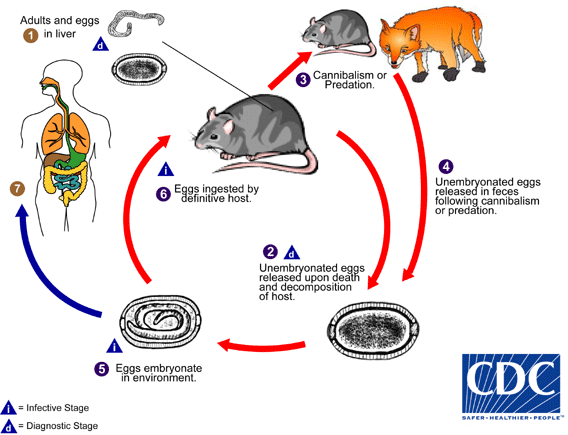Biology - Life Cycle of Capillaria hepatica
Life Cycle:

Capillaria hepatica has a direct life cycle that requires only one host. Adult worms invade the liver of the host (usually rodents, but may also be pigs, carnivores and primates, including humans), and lay hundreds of eggs in the surrounding parenchyma ![]() . The eggs are not passed in the feces of the host, and remain in the liver until the animal dies and decomposes
. The eggs are not passed in the feces of the host, and remain in the liver until the animal dies and decomposes ![]() , or is eaten by a predator or scavenger
, or is eaten by a predator or scavenger ![]() . Eggs ingested by such an animal are unembryonated, are not infectious, and are passed in the feces, providing an efficient mechanism to release eggs into the environment
. Eggs ingested by such an animal are unembryonated, are not infectious, and are passed in the feces, providing an efficient mechanism to release eggs into the environment ![]() . Cannibalism has been reported as an important role in transmission among rodent populations. Eggs embryonate in the environment
. Cannibalism has been reported as an important role in transmission among rodent populations. Eggs embryonate in the environment ![]() , where they require air and damp soil to become infective. Under optimal conditions, this takes about 30 days. The cycle continues when embryonated eggs are eaten by a suitable mammalian host
, where they require air and damp soil to become infective. Under optimal conditions, this takes about 30 days. The cycle continues when embryonated eggs are eaten by a suitable mammalian host ![]() . Infective eggs hatch in the intestine, releasing larvae. The larvae migrate via the portal vein to the liver. Larvae take about four weeks to mature into adults and mate. Humans are usually infected after ingesting embryonated eggs in fecal-contaminated food, water, or soil
. Infective eggs hatch in the intestine, releasing larvae. The larvae migrate via the portal vein to the liver. Larvae take about four weeks to mature into adults and mate. Humans are usually infected after ingesting embryonated eggs in fecal-contaminated food, water, or soil ![]() . Occasionally in humans, larvae will migrate to the lungs, kidneys, or other organs. The presence of C. hepatica eggs in human stool during routine ova-and-parasite (O&P) examinations indicates spurious passage of ingested eggs, and not a true infection. Diagnosis in humans is usually achieved by finding adults and eggs in biopsy or autopsy specimens.
. Occasionally in humans, larvae will migrate to the lungs, kidneys, or other organs. The presence of C. hepatica eggs in human stool during routine ova-and-parasite (O&P) examinations indicates spurious passage of ingested eggs, and not a true infection. Diagnosis in humans is usually achieved by finding adults and eggs in biopsy or autopsy specimens.
- Page last reviewed: January 10, 2012
- Page last updated: January 10, 2012
- Content source:


 ShareCompartir
ShareCompartir